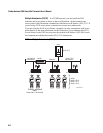
nugget
39
Configuring the Terminal
2-13
2
For example, if your application size is 64K and drive E is configured as a 256K RAM
drive, you are using 320K of the 512K application execution space. The application
uses the remaining 192K of RAM as a Malloc/free dynamic memory pool.
By default, the RAM drive is not configured and the memory is available for
applications. You can configure the size of the RAM drive (E) and use drive E to
temporarily store data and files (up to 128 files).
After you disable or configure the RAM drive, you must save the configuration in flash
memory and boot the terminal for the change to take effect. For help, see “Saving
Configuration Changes in Flash Memory” in Chapter 2 of the 2400 Family system
manual.
Note:
When you boot or reset the terminal, all files on the RAM drive are destroyed.
For help configuring the RAM drive, see “RAM Drive Size” in Chapter 6 of the 2400
Family system manual.
Configuring Flash Memory
You can use the 2MB extended flash memory either to store double-byte fonts or to use
as a 2MB drive. By default, the 2MB of flash memory is configured to store a double-
byte font set (up to 2MB maximum).
If you are not using double-byte fonts, you can configure the 2MB flash memory as a
storage drive (D). If you configure the flash memory as drive D, use this drive to store
large lookup tables and data files (up to 128 files).
Note:
You can only configure the 2MB flash memory as a drive or to store fonts. You
cannot use the space for both. If you configure drive D, you cannot store a font in flash
memory.
For help configuring flash memory, see “Flash Memory Configuration” in Chapter 6 of
the 2400 Family system manual. For help loading double-byte fonts, see “Loading
Double-Byte Fonts” in Chapter 2 of the 2400 Family system manual.


















